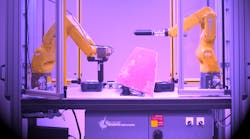Meaningful research can take place both on a large and small scale. Through small business innovation research (SBIR) programs and cooperative research and development agreement (CRADAs), the U.S. Air Force Research Laboratory (AFRL) can advance technology while providing increased protection for the armed forces. By means of a CRADA with Compass Technology Group, the AFRL is loaning a sophisticated sensor system to the electronics company to evaluate how well different coatings guard against microwave energy. The system is being used to test the EM shielding effectiveness of coatings used on radomes and aircraft.
The borrowed system is a smaller version of the microwave mapping-transparency sensor system (MM-TSS) produced by Compass Technology for the AFRL Materials and Manufacturing Directorate (AFRL/RX); the smaller version of the system was developed as part of the proof of concept for the SBIR using probes from Compass Technology. The system (see photo) combines robotic arms with microwave mapping probes to measure the effectiveness of different coatings on high-frequency electromagnetic (EM) energy. Compass Technology will use the robotic measurement system to perform nondestructive testing on different coatings and materials and, in so doing, further the company’s knowledge of those coatings and materials.
“This agreement gives us access to equipment that as a small business we wouldn’t have,” said Becky Schultz, chief executive officer of Compass Technology.
The system also includes advanced RF processing and human-machine interface software and tools. The combination of the automation and the wideband microwave probe technology greatly improves the measurement capability, saving time during the manufacturing processes involved in applying these microwave-energy-blocking coatings to aircraft cockpits and radomes. Analysis of the coatings, for example, helps to determine optimum thicknesses for suppressing microwave radiation without preventing the normal operation of the radomes.
“CRADAs are versatile mechanisms for collaboration, as well as research and development,” said Joshua Forbes, a program manager for AFRL/RX. “In cases like this, they benefit the government with cutting-edge research while enabling small business growth. They can have a serious impact.”
The research will also carry repercussions for commercial markets. “Most of the testing that we are doing on Air Force aircraft coatings is also needed in the commercial market,” said John Schultz, chief scientist at Compass Technology. “In addition to that, marine vehicles have radomes and need similar radome coating testing. With this equipment, Compass Technology now has the capability to conduct testing in both of those markets.”


